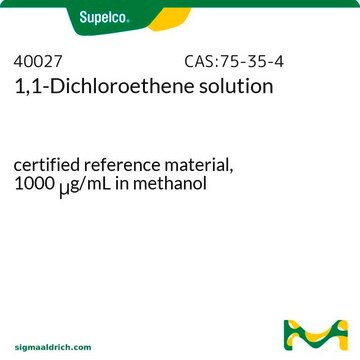163023
1,1-Dichloroethylene
contains 200 ppm MEHQ as inhibitor, 99%
Synonyme(s) :
Vinylidene chloride
About This Item
Produits recommandés
Densité de vapeur
3.46 (vs air)
Pression de vapeur
9.68 psi ( 20 °C)
Pureté
99%
Forme
liquid
Température d'inflammation spontanée
968 °F
Contient
200 ppm MEHQ as inhibitor
Limite d'explosivité
15.5 %
Point d'ébullition
30-32 °C (lit.)
Pf
−122 °C (lit.)
Densité
1.213 g/mL at 20 °C (lit.)
Température de stockage
2-8°C
Chaîne SMILES
ClC(Cl)=C
InChI
1S/C2H2Cl2/c1-2(3)4/h1H2
Clé InChI
LGXVIGDEPROXKC-UHFFFAOYSA-N
Vous recherchez des produits similaires ? Visite Guide de comparaison des produits
Application
Mention d'avertissement
Danger
Mentions de danger
Classification des risques
Acute Tox. 3 Oral - Acute Tox. 4 Inhalation - Carc. 2 - Eye Irrit. 2 - Flam. Liq. 1 - Skin Irrit. 2
Code de la classe de stockage
3 - Flammable liquids
Classe de danger pour l'eau (WGK)
WGK 3
Point d'éclair (°F)
-2.2 °F
Point d'éclair (°C)
-19 °C
Équipement de protection individuelle
Eyeshields, Faceshields, Gloves
Faites votre choix parmi les versions les plus récentes :
Déjà en possession de ce produit ?
Retrouvez la documentation relative aux produits que vous avez récemment achetés dans la Bibliothèque de documents.
Les clients ont également consulté
Notre équipe de scientifiques dispose d'une expérience dans tous les secteurs de la recherche, notamment en sciences de la vie, science des matériaux, synthèse chimique, chromatographie, analyse et dans de nombreux autres domaines..
Contacter notre Service technique












